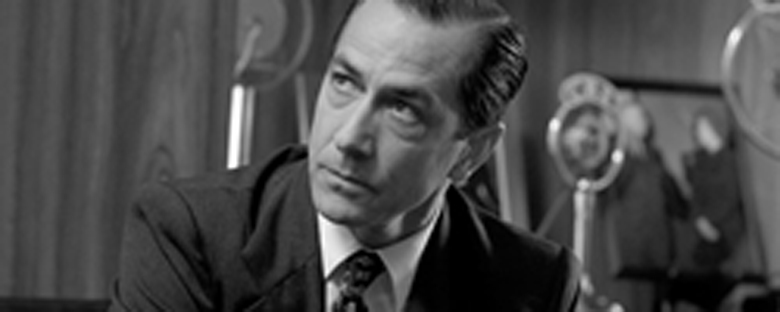Reviews
George Clooney
USA, 2005
Credits
Review by Beth Gilligan
Posted on 24 September 2005
Source Warner Independent Pictures 35mm print
Related articles
Features: The 43rd New York Film Festival
Actors’ passion projects often have the unfortunate tendency of morphing into insufferable vanity pieces. Having witnessed him radiate self-satisfaction through the duration of Ocean’s Twelve, I had every reason to believe that George Clooney, champion of liberal causes and People magazine’s former Sexiest Man Alive (1997), would turn in a chest-thumping film with a message laid out in the same colors as its cinematography. As it turns out, I was (mercifully) wrong. Clooney’s sophomore feature as a director, Good Night, and Good Luck, is a work of uncommon intelligence, weighing the topics it puts forth with a gravity not often found in American cinema today. Where Clooney and his co-screenwriter Grant Heslov could have fashioned an uplifting story about the good guys trumping they bad, they instead show us how a group of men won the battle, but — in the long run — lost the war.
In another decision atypical of a star’s directorial effort, Clooney casts David Straithairn in the lead role of CBS newsman Edward R. Murrow, relegating himself to the sidelines in the decidedly non-flashy role of Fred Friendly, Murrow’s trusted producer. Patricia Clarkson, Robert Downey Jr., Frank Langella, and Ray Wise round out the uniformly excellent cast.
Taking place over a relatively lean running time of 90 minutes, the movie dives right into the action, opening with a stone-faced Murrow being honored at an awards dinner in 1958. As the other guests cheerfully mingle, Murrow climbs onto the stage and announces, “This just might do nobody any good,” and promptly launches into a sharply-worded (and jaw-droppingly relevant) critique of broadcast journalism. From here, we are whisked back in time five years, as Murrow and his team of producers and reporters uncover the story of Milo Radulovich, an air force pilot who has been stripped of his duty for reasons that are never explained to him, but most likely have to do with the supposed Communist sympathies of his father and sister.
At the time, Senator Joseph McCarthy dominated news coverage for his virulent anti-Communist crusade, during which he regularly swept aside basic civil liberties and evidence in targeting citizens whom he suspected had ties to the Party. Sensing that Radulovich might be a victim of this, Murrow and his team decide to expose the Senator’s unethical tactics, devoting an entire broadcast to what would later come to be known as the Communist witch-hunts. As the film goes on, the battle escalates, and Senator McCarthy is not the only one to pay a price for his actions.
Throughout Good Night, and Good Luck, which is shot entirely in black & white, archival footage of real-life people, including McCarthy (Clooney opted not to use an actor to portray him), is interspersed, bolstering the film’s convincing re-creation of the era. A trail of cigarette smoke winds its way through frame after frame, and the claustrophobia of the newsroom as well as the imposing office of the network’s top executives are impeccably portrayed. Like Murrow himself, the film refuses to make any grandiose political statements for or against Communism, maintaining a steady focus on the events as they unfolded.
While Murrow and his colleagues’ heroism is not left to doubt, Clooney doesn’t allow the audience to bask in their success at putting the brakes on McCarthy. After the newscaster makes his carefully-worded case against the Senator in the Radulovich piece, the newsroom bursts into applause, and yet the director drowns out the sound, eventually giving way to a melancholy jazz tune. Throughout the film, Clooney carefully counterbalances Murrow’s astonishingly eloquent speeches about the nation’s political climate with the celebrity-laden puff pieces he’s forced to do by his bosses to boost ratings.
As the movie’s opening and closing scenes emphasize, broadcast journalism hovers perilously close to being swallowed whole by the world of entertainment, its substance giving way to ratings-friendly blather and toothless journalism. Given the relevancy of Murrow’s damning statements nearly fifty years after they were first uttered, it makes sense that Clooney and Heslov choose to deprive their audience of a Hollywood ending, recognizing the hollow note it would inevitably ring. And yet, to consider Good Night, and Good Luck a pessimistic critique of the media would be missing the point. Murrow’s electrifying speeches are, above all else, a rallying cry, a call for the television media to embrace its possibilities as an agent of change and a conveyor of important information. Or, as Murrow himself put it, “This instrument can teach, it can illuminate; yes, and it can even inspire. But it can do so only to the extent that humans are determined to use it to those ends. Otherwise it is merely wires and lights in a box.”
We don’t do comments anymore, but you may contact us here or find us on Twitter or Facebook.



